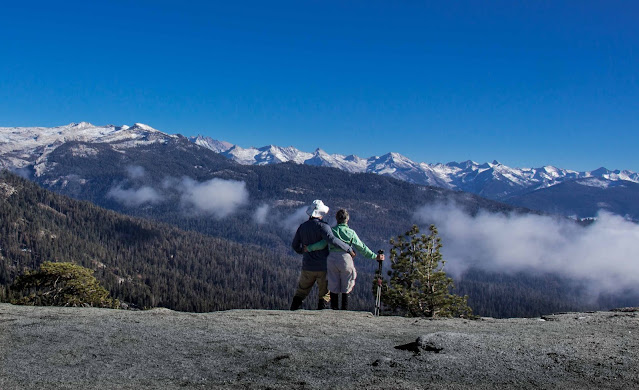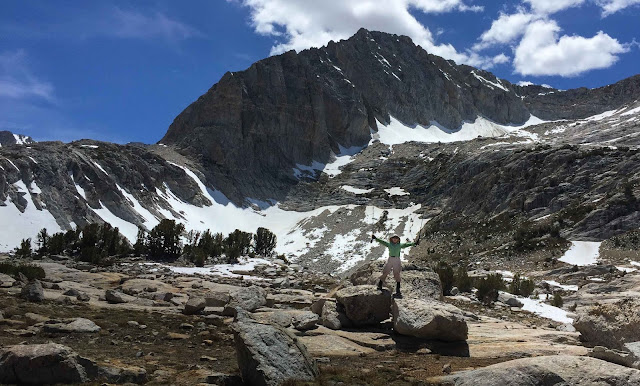We wanted a brief socially-distant trip so that we could watch the Geminid meteor shower. Solution: the Mojave Desert, just 200 miles away. Although all of the campgrounds and state parks were closed, the BLM still allowed boondocking in certain areas, including the Kelso Dunes.
I was concerned that the sites would be too sandy for the trailer, but the surface was great -- no problem. It was a surprisingly chilly afternoon:
Those are the Providence Mountains behind me. If you look carefully, you can see that the rock is metamorphic, rather than igneous, which is unusual in this general area:
After we got the campsite set up, we took a long walk. The dunes were very dramatic in the slanting late afternoon December sunlight. This shot can't quite capture the silence, the emptiness, and the cold wind:
As we walked, we could see a number of places where folks in those monster trucks had left the road and had ridden right over the "no motor vehicles" signs posted all along the roadway, tearing up the soil and killing the vegetation. It wouldn't surprise me if someday soon, the BLM were to completely ban boondocking, in an effort to preserve the desert, even though the culprits are probably not campers but are just "day-use vandals." (Good name for a rock band!)
This is another in a series of "little trailer in a big landscape" pictures -- the trailer (the lonely white dot in the right center) was reflecting the last rays of the sun:
That evening, just after dark, some rude late-comers drove over the bushes and wedged their truck right next to our trailer, even though the site was clearly meant for just one rig. (Fortunately, they were very quiet and left the next morning.)
The weather prediction for the meteor shower was for cloudy skies during the evening with clear skies after midnight. Wrong. It got very cloudy but did not clear till the next morning. We saw a few dim meteors when we went out for our after-dinner walk, but nothing spectacular. The cloud cover reflected a surprising amount of light pollution from Las Vegas, a hundred miles away. (We have become spoiled by the ultra-dark skies in the Eastern Sierra.). There was also light pollution to our west -- maybe Barstow?
December 14: Since I was about seven or eight years old (during the Eisenhower Administration!), I have always wanted to explore a volcano and to climb down into the crater. Amboy Crater was less than an hour's drive from our campsite -- a perfect opportunity to scratch that itch.
Kelbaker Road, our route to Amboy, took us past the Granite Mountains. These were unusual -- most of the mountains in the Mojave appear to be volcanic, but these had that "intrusive batholith" quality common to the Sierra, far to the northwest. (Translation: blobs of molten rock that had risen from deep in the earth.) The outcroppings had eroded into bizarre shapes:
Amboy Crater was about a mile and a half from the parking area. Felice is standing on a lava flow. From this perspective, the northern edge of the cone looks symmetrical (unlike the southwestern side):
The volcano had thrown out blobs of lava -- the gases within the lava had created bubbles, preserved as the molten rock cooled:
The trail to the crater snaked through mounds of ejecta and lobes of lava flows. There were a number of big circular depressions in the lava field -- we could not figure out what those were, because they did not look like little volcanic craters or vents. (No sidewalls!) A little research indicates that these are "collapse depressions," in which thin crusts over fluid lava collapsed, leaving a void in the flow.
The hike was not difficult at all, especially since the weather was so chilly. It would be very tough in the heat of summer. The climb up to the edge of the crater itself was not too bad -- a little steep, a little slippery.
In this shot, I am standing in the crease on the southwest side of the mountain, where the volcano had erupted sideways (like Mt. St. Helens, only much smaller). The crater had erupted several times, leaving superimposed lava fields:
If you look carefully in the center of this next shot, I am in the middle of the crater -- we had it all to ourselves. The floor of the crater was a lava lake. Some sand and clay had blown into the crater and had gotten trapped there, leaving a smooth surface:
The nearby town of Amboy was sort of a living museum of the pre-interstate days of Route 66, complete with late 40s/early 50s architecture:
That night was beautifully clear (and cold -- about 30 degrees). Dressed in heavy clothing and draped in a sleeping bag, we sat outside for about 45 minutes, hoping for some leftover meteors. The stars were excellent, and there were a few faint meteors, but nothing amazing.
December 15: We walked up into the Kelso Dunes. The sand was like flour -- very loose and powdery. As you'd expect, we would take a step and would slide back a half step. It was a lot of effort, but fortunately it was another chilly, sunny day.
Felice used her iPhone to capture the wind-driven ripples in the dunes. The pattern was accentuated by the contrasting sand particles -- the high part of each undulation trapped the darker particles, while the depressions between the ripples were composed of light beige sand. We could not figure out how the wind had sorted the sand in this way -- perhaps the black particles were lighter or heavier than the beige grains:
Given the harsh conditions, it was surprising to see that there were some fairly big plants growing out of the soft sand. (I tried to figure out what this was but have had no luck.) I read that the larger plants growing on the dunes put out long, deep roots that reach the water table within the dunes, far below the surface:
The grasses were whipped back and forth by the shifting wind, creating some great patterns in the sand:
Although we got close to the top of the dunes, we decided not to go all the way to the top -- the view from partway up was pretty spectacular:
From our vantage point, we could see the trailer in the desert below -- yet another "lonely trailer" shot. It's in the upper left corner:
Later that afternoon, we headed over to a boulder field near Granite Pass, just to do a little exploring:




























































